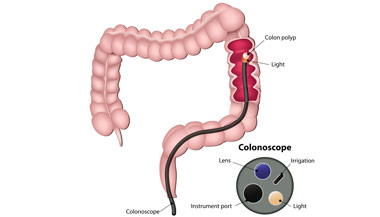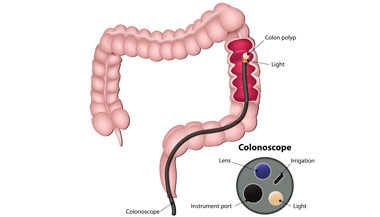Colon Cancer Diagnosis
Since you may not experience symptoms during the early stages of disease, you should undergo regular exams to screen for colon cancer and rectal cancer. If cancer is present, screening allows it to be caught and treated early, ensuring the best possible outcome. Several tests are available to screen and test for colon and rectal cancers.
Colon and Rectal Cancer Screening Recommendations
The combination of screening and prevention is important in the fight against colon cancer and rectal cancer. Talk to your doctor about your risk factors and when you should begin screening. For Americans, screening for colon and rectal cancers should start no later than age 50. Depending on your personal or family history, your doctor may recommend that you start screening for colon cancer and rectal cancer at an earlier age.
Polyps and Cancer Prevention
Polyps are precancerous growths that develop in the colon or rectum. Some types of polyps have the potential to grow and become cancerous.
Polyps are found in 1 in 4 people who undergo colonoscopy. Polyps or cancers that are found early can often be removed without the patient having surgery. The cure rate in these cases is close to 100 percent. Removing polyps from the colon may reduce your risk of developing colon cancer in the future.
Tests for Colon and Rectal Cancer Screening and Diagnosis
Several types of laboratory tests, clinical tests and examinations are used to detect colon and rectal cancers.
The exams are relatively simple and painless, though some patients do experience minor discomfort requiring mild anesthetics. The tests include the following:
Fecal Occult Blood Test
This blood test looks for occult (hidden) blood in the stool. For this test:
-
You will receive three small cards. Place a stool sample from three consecutive bowel movements on each card.
-
A small amount of the stool is placed on a special test strip.
-
The stool is analyzed for traces of blood.
Barium Enema
A barium enema (also called a lower GI series) is used to create an X-ray of the rectum and colon. Before the procedure, you will need to clear your colon of any stool. Preparations may include a liquid diet, an enema and laxatives.
During a barium enema:
-
A barium preparation (a chalky, liquid contrast material) is inserted through a rectal tube.
-
The barium outlines the colon, highlighting any abnormalities. The doctor also expands the colon by gently pumping air into it.
-
An X-ray is taken.
-
Your doctor examines the entire colon to see if polyps or cancer are present.
Flexible Sigmoidoscopy
A flexible sigmoidoscopy is used to examine the rectum and lower colon. Prior to a flexible sigmoidoscopy, your colon must be clear of stool to enable good visibility. Preparations may include a liquid diet, an enema and laxatives.
During the procedure:
-
Your doctor inserts a sigmoidoscope (a thin, flexible tube) through the rectum and into the anus and large intestine to see if cancer or polyps are present.
-
Biopsy forceps may be inserted through the scope to remove a small sample of tissue for further analysis.
Colonoscopy
Colonoscopy is the most widely used diagnostic test to study the colon. It has the highest sensitivity of all tests. Doctors can examine 90 percent to 95 percent of the colon during most colonoscopies. Prior to the procedure, your colon must be clear of stool so that your doctor has good visibility. Preparations may include a liquid diet, an enema and laxatives.
A colonoscopy involves the following:
-
You will most likely receive medication to sedate you.
-
Your doctor inserts the colonoscope through the rectum and into the anus and large intestine to see if cancer or polyps are present. A polyp can be removed through the colonoscope.
-
Biopsy forceps may be inserted through the scope to remove a small sample of tissue for further analysis.
Virtual Colonoscopy
Virtual colonoscopy, which is also known as computed tomography (CT) colonography, is used to screen for colon cancer and rectal cancer using CT imaging. This procedure is done in the radiology department and without sedation.
A virtual colonoscopy involves the following steps:
-
Similar to a standard colonoscopy, you must take a laxative preparation the night before to clear your colon of stool.
-
Air will be pumped into your colon for this exam, which might cause some cramping.
-
No polyps can be biopsied or removed during a virtual colonoscopy. If a polyp is identified, you will be referred for a traditional colonoscopy.
Stool DNA Test
A stool DNA test involves a commercial kit that your doctor must first prescribe for use as a colon and rectal cancer screening test. Special DNA testing is done on a stool sample that you provide to detect the presence of abnormal cells that are shed from large polyps or cancers. The test involves the following steps:
-
The test kit is shipped to your home where you collect the stool sample before sending it back to the company.
-
Your doctor receives the test results and shares them with you.
-
If the test is positive, you will likely need to have a colonoscopy to confirm the findings.
Additional Resources
Additional screening recommendations are offered by the following organizations:






